|
Reseña:
|
Theory: The development of judicial viability involves a process by which constitutional courts attain institutional stability and value as an end in itself. Institutional stability denotes the courts’ capacity to withstand environmental shocks, while value involves entities acquiring a distinctive mission and identity in the newly-democratized governmental system. More precisely, we argue that constitutional courts attain functional (substantive) viability when they attain high levels of three features: differentiation (unique character and mission), autonomy (functional insularity), and durability (institutional resilience and adaptability). The emergence of judicial viability, therefore, lies in the interplay of these features over time.Hypotheses: Courts with greater degrees of differentiation, autonomy, and durability will possess higher levels of viability.Methods: We choose several indicators of the component features of viability, measure them across twenty-eight post-communist courts on an annual basis, and then employ factor analysis to reduce the eleven variables of our judicial viability model to their underlying dimension. To produce the judicial viability score, we use the Bartlett weighted least squares method to produce factor scores. Additionally, we follow the same procedure and create two uncorrelated variables using the first two eigenvalue and eigenvector pairs that are linearly related to the original judicial viability models.Results: Factor analyzing the eleven indicators of judicial differentiation, autonomy, and durability presents strong support for the stated hypotheses. Our results indicate that constitutional courts operate as viable institutions when all three components (differentiation, autonomy and durability) are attained at meaningful levels. A single factor score representing judicial viability explains 89% of the sample variance and accounts for all three component dimensions. Therefore, our results demonstrate that a single underlying dimension of judicial viability exists and that it is possible to examine the extent of institutional development in the judicial through a systematic analysis of formal provisions over time. |



